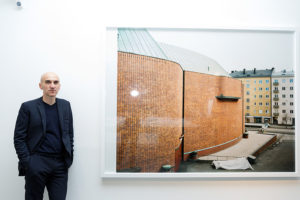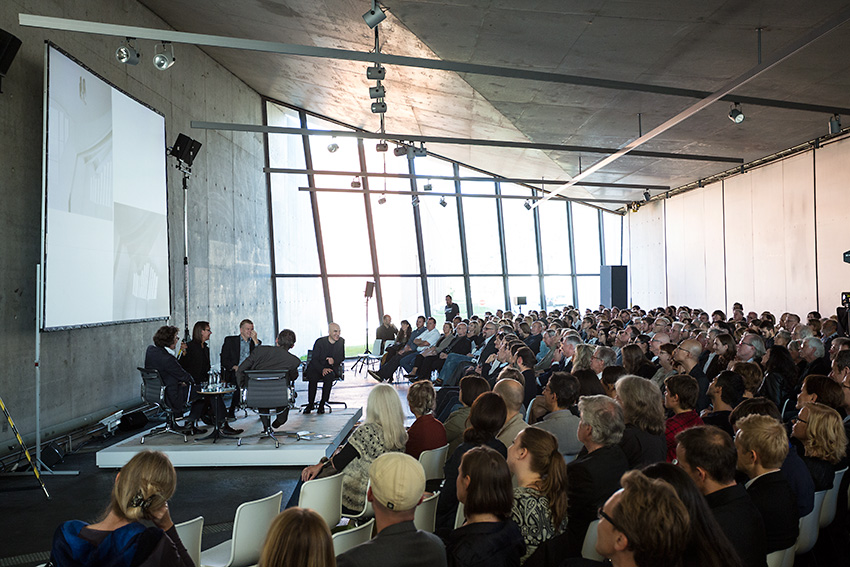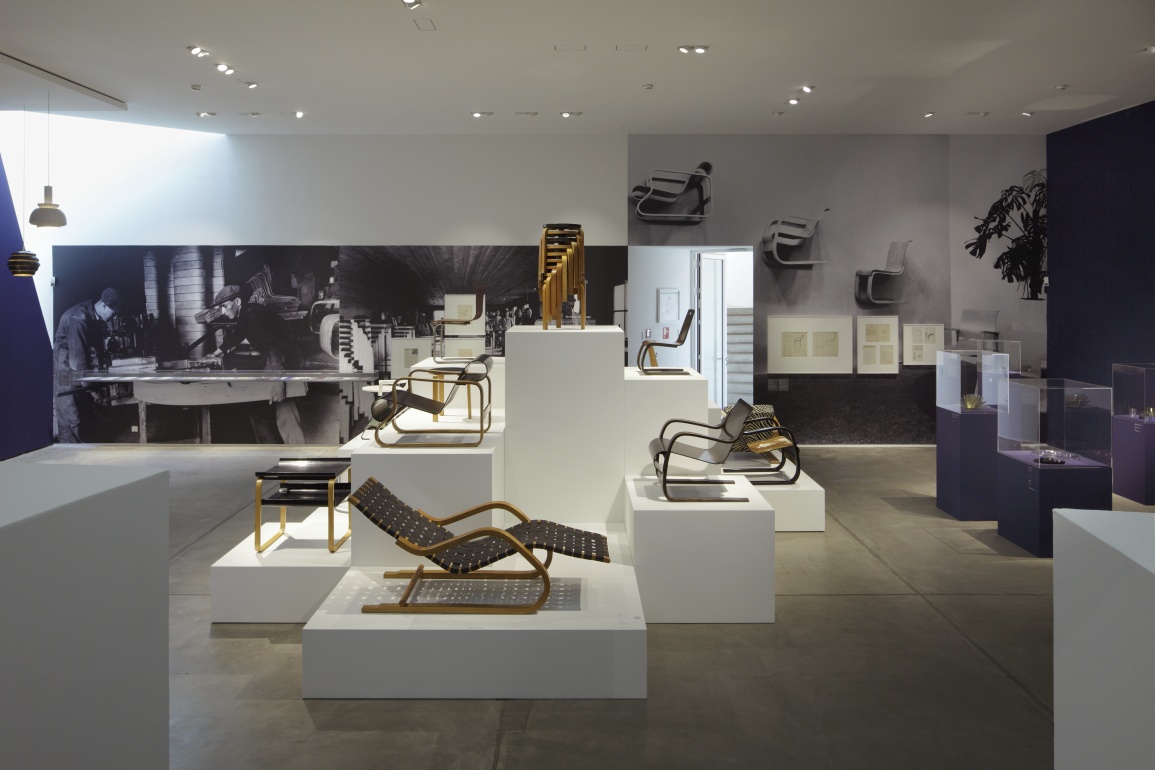Back to articles
Unmediated Alvar Aalto at Vitra Design Museum
Vitra Design Museum, in collaboration with the Alvar Aalto Museum, hosts a major retrospective exhibition dedicated to the legendary Finnish architect Alvar Aalto until 1st March 2015. Arianna Callocchia from Italy writes about the Alvar Aalto – Second Nature exhibition and discusses its contents and objectives.Arianna Callocchia: Why did you decide to host an exhibition on the architect in a design museum?
Mateo Kries, Director of the Vitra Design Museum: "Alvar Aalto’s designs have always been very important components of our vast collection of 6,000 pieces of furniture. We felt it was time that we focused seriously on Aalto’s work."
Tommi Lindh, Director, architect SAFA Alvar Aalto Foundation & Museum: "The Vitra Design Museum has had an exhibition dedicated to Aalto in the pipeline since its foundation. The idea was submitted to my predecessor Dr. Susanna Pettersson in 2012. We are the co-organizers of the exhibition. However, the Vitra Design Museum is in charge of the layout."AC: Can you describe the special features of this exhibition?
Mateo Kries: "While previous exhibitions and publications have focused on Aalto’s organic architectural language that derived directly from the nature and landscape of Finland, »Alvar Aalto – Second Nature« takes a new, more contemporary look at his work. Our exhibition explores how Aalto’s affinity to the organic form was mediated by intense dialogue with many artists of his time, such as László Moholy-Nagy, Jean Arp, Alexander Calder or Fernand Léger. Works by these and other artists contrast with Aalto’s designs and buildings, illustrating his importance as a figurehead of avant-garde international art and architecture from the 1920s onwards." Professor Armin Linke, photographer. Photo credit: Bettina Matthiesen, Kuvasto 2014.[/caption]The layout of the exhibition is basic and stylish and it is designed by the German architect, Wilfried Kuehn, a partner in the Berlin studio Kuehn Malvezzi. His exhibition pathway was devised to contrast and interface with the astonishing architecture of the Vitra Design Museum designed by the American architect, Frank O. Gehry.Kuehn explains the concept behind his layout design: "Our exhibition architecture creates a spatial narrative by designing four radically different spaces in relation to the curatorial themes." He describes the guidelines of his project:
Professor Armin Linke, photographer. Photo credit: Bettina Matthiesen, Kuvasto 2014.[/caption]The layout of the exhibition is basic and stylish and it is designed by the German architect, Wilfried Kuehn, a partner in the Berlin studio Kuehn Malvezzi. His exhibition pathway was devised to contrast and interface with the astonishing architecture of the Vitra Design Museum designed by the American architect, Frank O. Gehry.Kuehn explains the concept behind his layout design: "Our exhibition architecture creates a spatial narrative by designing four radically different spaces in relation to the curatorial themes." He describes the guidelines of his project: Lecture event at the Alvar Aalto exhibition opening at Vitra Design Museum. Photo credit: Bettina Matthiesen, Kuvasto 2014.[/caption]Eeva-Liisa Pelkonen, Ph.D., Associate Professor Director, M.E.D. Program at Yale University, one of the guest speakers at the opening talk stated: “I think Aalto is one of if not the best and most moving architects of the 20th century. We can keep on learning from his sensitivity to both natural and urban contexts, his creative use of materials and his amazing ability to choreograph interior spaces”.Jochen Eisenbrand, exhibition curator of »Alvar Aalto – Second Nature«, concluded: "I think there are several reasons why Aalto’s work is still important today. He created architecture that is modern yet warm and welcoming; spaces that are so saturated with details and combinations of different materials; furniture and lighting that they speak to all senses (audiovisual and tactile); and he demonstrated that it is possible to be regionally-rooted and become truly universal at the same time."Juho Grönholm, architect SAFA, ALA Architects, added: "Aalto's oeuvre is still very important and very much alive. He took part in the transition to modernism and the transition that extended even further than that. His long career crossed several interesting periods".
Lecture event at the Alvar Aalto exhibition opening at Vitra Design Museum. Photo credit: Bettina Matthiesen, Kuvasto 2014.[/caption]Eeva-Liisa Pelkonen, Ph.D., Associate Professor Director, M.E.D. Program at Yale University, one of the guest speakers at the opening talk stated: “I think Aalto is one of if not the best and most moving architects of the 20th century. We can keep on learning from his sensitivity to both natural and urban contexts, his creative use of materials and his amazing ability to choreograph interior spaces”.Jochen Eisenbrand, exhibition curator of »Alvar Aalto – Second Nature«, concluded: "I think there are several reasons why Aalto’s work is still important today. He created architecture that is modern yet warm and welcoming; spaces that are so saturated with details and combinations of different materials; furniture and lighting that they speak to all senses (audiovisual and tactile); and he demonstrated that it is possible to be regionally-rooted and become truly universal at the same time."Juho Grönholm, architect SAFA, ALA Architects, added: "Aalto's oeuvre is still very important and very much alive. He took part in the transition to modernism and the transition that extended even further than that. His long career crossed several interesting periods". View of the exhibition, room 3. Foto / photo: © Vitra Design Museum, Ursula Sprecher, VG Bild-Kunst, Bonn, 2014.[/caption]The »Alvar Aalto – Second Nature« exhibition is described in a detailed catalogue (688 pages). It contains articles written by ten experts, including Eeva-Liisa Pelkonen, Akos Moravanszky and Pedro Gadanho, the curator of MoMA, NY. The catalogue also includes interviews with Kenneth Frampton and Alvaro Siza, and a comprehensive list of the works, original designs and illustrations presented to the public for the first time.
View of the exhibition, room 3. Foto / photo: © Vitra Design Museum, Ursula Sprecher, VG Bild-Kunst, Bonn, 2014.[/caption]The »Alvar Aalto – Second Nature« exhibition is described in a detailed catalogue (688 pages). It contains articles written by ten experts, including Eeva-Liisa Pelkonen, Akos Moravanszky and Pedro Gadanho, the curator of MoMA, NY. The catalogue also includes interviews with Kenneth Frampton and Alvaro Siza, and a comprehensive list of the works, original designs and illustrations presented to the public for the first time.
Spatial narrative of Aalto
The exhibition »Alvar Aalto – Second Nature« presents the most important pieces of Aalto’s work and a selection of the lesser-known creations, original sketches and designs, historical architectonic models, videos and large black and white and color photographs.Eye-catching photographs and film clips of Aalto’s most stylish buildings immortalized by the German artist Armin Linke can be examined in all sections of the exhibition and interface with the historical material from the archives of the Alvar Aalto Foundation and from other international sources that loaned their pieces for the event. In addition to the architecture, the exhibition also presents the design work completed by Aalto and dedicates an entire room to models of his lamps, his seating and his glass creations. It includes the famous vase created in 1936 and now recognized as an iconic piece of international design. Aalto's creativity is evident in a section dedicated to his graphic projects published in books or brochures. And finally, there is a selection of projects by his peers, such as László Moholy-Nagy, Jean Arp, Alexander Calder and Fernand Léger, that stand side-by-side with the architecture plans for his buildings.[caption id="attachment_1508" align="aligncenter" width="300"] Professor Armin Linke, photographer. Photo credit: Bettina Matthiesen, Kuvasto 2014.[/caption]The layout of the exhibition is basic and stylish and it is designed by the German architect, Wilfried Kuehn, a partner in the Berlin studio Kuehn Malvezzi. His exhibition pathway was devised to contrast and interface with the astonishing architecture of the Vitra Design Museum designed by the American architect, Frank O. Gehry.Kuehn explains the concept behind his layout design: "Our exhibition architecture creates a spatial narrative by designing four radically different spaces in relation to the curatorial themes." He describes the guidelines of his project:
Professor Armin Linke, photographer. Photo credit: Bettina Matthiesen, Kuvasto 2014.[/caption]The layout of the exhibition is basic and stylish and it is designed by the German architect, Wilfried Kuehn, a partner in the Berlin studio Kuehn Malvezzi. His exhibition pathway was devised to contrast and interface with the astonishing architecture of the Vitra Design Museum designed by the American architect, Frank O. Gehry.Kuehn explains the concept behind his layout design: "Our exhibition architecture creates a spatial narrative by designing four radically different spaces in relation to the curatorial themes." He describes the guidelines of his project:Our idea was to show the original exhibits — be they historical or contemporary artistic originals — in an unmediated manner that will give the visitor a very realistic and direct experience. The spaces express specific themes and consequently each requires a very particular form and surface, different light and a specific color. However, all of these decisions are not taken in a decorative or scenographic way as the visitor is moving through the exhibition and does not stop to look at a static stage scene. We have envisaged every moment of the exhibition from the point of view of the moving visitor who has his own personal way of looking at and perceiving the exhibition and may actually co-produce the space subjectively. — Wilfried Kuehn, Architect, Exhibition Designer, Collector; Berlin, Germany[gallery columns="4" ids="eyJ1cmwiOmZhbHNlLCJ0aXRsZSI6IkdvbGRlbiBDdWJlcyAtIGFya2tpdGVodHV1cmlrYXN2YXR1a3NlbiBrYW5zYWxsaW5lbiBvc2FraWxwYWlsdSByYXRrZW5udXQiLCJjYXB0aW9uIjpmYWxzZSwiYWx0IjoiIiwiZGVzY3JpcHRpb24iOiJLYW5zYWludlx1MDBlNGxpc2VlbiBBcmNoaXRlY3R1cmUgJmFtcDsgQ2hpbGRyZW4gR29sZGVuIEN1YmVzIEF3YXJkcyAta2lscGFpbHV1biBsXHUwMGU0aHRlZSBTdW9tZXN0YSBuZWxqXHUwMGU0IHZvaXR0b2lzYWEgZWhkb3R1c3RhLiBTYXJqYXNzYSBTY2hvb2wgQXdhcmQgc3VvbWFsYWlzdGEgYXJra2l0ZWh0dXVyaWthc3ZhdHVzdGEgZWR1c3RhYSBNYXNhbGFuIGtvdWx1biA8ZW0+TWFzYWxhc3RhIEh2aXR0clx1MDBlNHNraWluIFx1MjAxMyB0YWlkZWthc3ZhdHVzLSBqYSBrb3Rpc2V1dHVoYW5rZSBFbGllbCBTYWFyaXNlbiBoZW5nZXNzXHUwMGU0PFwvZW0+LCBzYXJqYXNzYSBJbnN0aXR1dGlvbiBBd2FyZCBBbm5hbnRhbG9uIHRhaWRla2Vza3Vrc2VuIDxlbT5LZWlkYXMgXHUyMDEzIGVsXHUwMGU0dlx1MDBlNCBvbG9odW9uZSBBbm5hbnRhbG9uIHBpaGFsbGU8XC9lbT4sIHNhcmphc3NhIFdyaXR0ZW4gTWVkaWEgTGFzdGVuIGphIG51b3J0ZW4gYXJra2l0ZWh0dXVyaWtvdWx1IEFya2luIDxlbT5UaWxhdCwgdGFsb3QgJmFtcDsga2F1cHVuZ2l0IC1vcGV0dXNtYXRlcmlhYWxpPFwvZW0+IHNla1x1MDBlNCBzYXJqYXNzYSBBdWRpby12aXN1YWwgTWVkaWEgUmFrZW5uZXRhYW4ga2F1cHVua2khIC10eVx1MDBmNnJ5aG1cdTAwZTRuIDxlbT5SYWtlbm5ldGFhbiBrYXVwdW5raSEgLWFya2tpdGVodHV1cmlvb3BwZXJhPFwvZW0+LiBPbm5pdHRlbHV0IFN1b21lbiBvc2FraWxwYWlsdW4gdm9pdHRhamlsbGUhIn0=,eyJ1cmwiOmZhbHNlLCJ0aXRsZSI6IkdvbGRlbiBDdWJlcyAtIGFya2tpdGVodHV1cmlrYXN2YXR1a3NlbiBrYW5zYWxsaW5lbiBvc2FraWxwYWlsdSByYXRrZW5udXQiLCJjYXB0aW9uIjpmYWxzZSwiYWx0IjoiIiwiZGVzY3JpcHRpb24iOiJLYW5zYWludlx1MDBlNGxpc2VlbiBBcmNoaXRlY3R1cmUgJmFtcDsgQ2hpbGRyZW4gR29sZGVuIEN1YmVzIEF3YXJkcyAta2lscGFpbHV1biBsXHUwMGU0aHRlZSBTdW9tZXN0YSBuZWxqXHUwMGU0IHZvaXR0b2lzYWEgZWhkb3R1c3RhLiBTYXJqYXNzYSBTY2hvb2wgQXdhcmQgc3VvbWFsYWlzdGEgYXJra2l0ZWh0dXVyaWthc3ZhdHVzdGEgZWR1c3RhYSBNYXNhbGFuIGtvdWx1biA8ZW0+TWFzYWxhc3RhIEh2aXR0clx1MDBlNHNraWluIFx1MjAxMyB0YWlkZWthc3ZhdHVzLSBqYSBrb3Rpc2V1dHVoYW5rZSBFbGllbCBTYWFyaXNlbiBoZW5nZXNzXHUwMGU0PFwvZW0+LCBzYXJqYXNzYSBJbnN0aXR1dGlvbiBBd2FyZCBBbm5hbnRhbG9uIHRhaWRla2Vza3Vrc2VuIDxlbT5LZWlkYXMgXHUyMDEzIGVsXHUwMGU0dlx1MDBlNCBvbG9odW9uZSBBbm5hbnRhbG9uIHBpaGFsbGU8XC9lbT4sIHNhcmphc3NhIFdyaXR0ZW4gTWVkaWEgTGFzdGVuIGphIG51b3J0ZW4gYXJra2l0ZWh0dXVyaWtvdWx1IEFya2luIDxlbT5UaWxhdCwgdGFsb3QgJmFtcDsga2F1cHVuZ2l0IC1vcGV0dXNtYXRlcmlhYWxpPFwvZW0+IHNla1x1MDBlNCBzYXJqYXNzYSBBdWRpby12aXN1YWwgTWVkaWEgUmFrZW5uZXRhYW4ga2F1cHVua2khIC10eVx1MDBmNnJ5aG1cdTAwZTRuIDxlbT5SYWtlbm5ldGFhbiBrYXVwdW5raSEgLWFya2tpdGVodHV1cmlvb3BwZXJhPFwvZW0+LlxyXG5cclxuR29sZGVuIEN1YmVzIFN1b21lbiBvc2FraWxwYWlsdW4gdHVvbWFyb2l2YXQ6IEhlaW5pIEtvcnBlbGFpbmVuXC8gU3VvbWVuIEFya2tpdGVodGlsaWl0dG8gU0FGQSwgSGFubmEgTFx1MDBlNG1zXHUwMGU0XC8gU3VvbWVuIGt1bHR0dXVyaXBlcmludFx1MDBmNmthc3ZhdHVrc2VuIHNldXJhLCBKb25uaSBSb29zXC8gWUxFLCBJbGtrYSBTYWxtaW5lblwvIFZlcnN0YXMgQXJra2l0ZWhkaXQgT3kgamEgSGVsZW5hIFRlclx1MDBlNHZcdTAwZTRpbmVuXC8gQWFsdG8teWxpb3Bpc3RvLCBUYWl0ZWlkZW4gamEgc3V1bm5pdHRlbHVuIGtvcmtlYWtvdWx1LlxyXG5cclxuT25uaXR0ZWx1dCB2b2l0dGFqaWxsZSBqYSBtZW5lc3R5c3RcdTAwZTQga2Fuc2FpbnZcdTAwZTRsaXNlZW4gbWl0dGVsXHUwMGY2XHUwMGY2biEifQ==,eyJ1cmwiOmZhbHNlLCJ0aXRsZSI6IkdvbGRlbiBDdWJlcyAtIGFya2tpdGVodHV1cmlrYXN2YXR1a3NlbiBrYW5zYWxsaW5lbiBvc2FraWxwYWlsdSByYXRrZW5udXQiLCJjYXB0aW9uIjpmYWxzZSwiYWx0IjoiIiwiZGVzY3JpcHRpb24iOiJLYW5zYWludlx1MDBlNGxpc2VlbiBBcmNoaXRlY3R1cmUgJmFtcDsgQ2hpbGRyZW4gR29sZGVuIEN1YmVzIEF3YXJkcyAta2lscGFpbHV1biBsXHUwMGU0aHRlZSBTdW9tZXN0YSBuZWxqXHUwMGU0IHZvaXR0b2lzYWEgZWhkb3R1c3RhLiBTYXJqYXNzYSBTY2hvb2wgQXdhcmQgc3VvbWFsYWlzdGEgYXJra2l0ZWh0dXVyaWthc3ZhdHVzdGEgZWR1c3RhYSBNYXNhbGFuIGtvdWx1biA8ZW0+TWFzYWxhc3RhIEh2aXR0clx1MDBlNHNraWluIFx1MjAxMyB0YWlkZWthc3ZhdHVzLSBqYSBrb3Rpc2V1dHVoYW5rZSBFbGllbCBTYWFyaXNlbiBoZW5nZXNzXHUwMGU0PFwvZW0+LCBzYXJqYXNzYSBJbnN0aXR1dGlvbiBBd2FyZCBBbm5hbnRhbG9uIHRhaWRla2Vza3Vrc2VuIDxlbT5LZWlkYXMgXHUyMDEzIGVsXHUwMGU0dlx1MDBlNCBvbG9odW9uZSBBbm5hbnRhbG9uIHBpaGFsbGU8XC9lbT4sIHNhcmphc3NhIFdyaXR0ZW4gTWVkaWEgTGFzdGVuIGphIG51b3J0ZW4gYXJra2l0ZWh0dXVyaWtvdWx1IEFya2luIDxlbT5UaWxhdCwgdGFsb3QgJmFtcDsga2F1cHVuZ2l0IC1vcGV0dXNtYXRlcmlhYWxpPFwvZW0+IHNla1x1MDBlNCBzYXJqYXNzYSBBdWRpby12aXN1YWwgTWVkaWEgUmFrZW5uZXRhYW4ga2F1cHVua2khIC10eVx1MDBmNnJ5aG1cdTAwZTRuIDxlbT5SYWtlbm5ldGFhbiBrYXVwdW5raSEgLWFya2tpdGVodHV1cmlvb3BwZXJhPFwvZW0+LlxuXG5Hb2xkZW4gQ3ViZXMgU3VvbWVuIG9zYWtpbHBhaWx1biB0dW9tYXJvaXZhdDogSGVpbmkgS29ycGVsYWluZW5cLyBTdW9tZW4gQXJra2l0ZWh0aWxpaXR0byBTQUZBLCBIYW5uYSBMXHUwMGU0bXNcdTAwZTRcLyBTdW9tZW4ga3VsdHR1dXJpcGVyaW50XHUwMGY2a2FzdmF0dWtzZW4gc2V1cmEsIEpvbm5pIFJvb3NcLyBZTEUsIElsa2thIFNhbG1pbmVuXC8gVmVyc3RhcyBBcmtraXRlaGRpdCBPeSBqYSBIZWxlbmEgVGVyXHUwMGU0dlx1MDBlNGluZW5cLyBBYWx0by15bGlvcGlzdG8sIFRhaXRlaWRlbiBqYSBzdXVubml0dGVsdW4ga29ya2Vha291bHUuXG5cbk9ubml0dGVsdXQgU3VvbWVuIG9zYWtpbHBhaWx1biB2b2l0dGFqaWxsZSBqYSBtZW5lc3R5c3RcdTAwZTQga2Fuc2FpbnZcdTAwZTRsaXNlZW4gbWl0dGVsXHUwMGY2XHUwMGY2biEifQ==,eyJ1cmwiOmZhbHNlLCJ0aXRsZSI6IkdvbGRlbiBDdWJlcyAtIGFya2tpdGVodHV1cmlrYXN2YXR1a3NlbiBrYW5zYWxsaW5lbiBvc2FraWxwYWlsdSByYXRrZW5udXQiLCJjYXB0aW9uIjpmYWxzZSwiYWx0IjoiIiwiZGVzY3JpcHRpb24iOiJLYW5zYWludlx1MDBlNGxpc2VlbiBBcmNoaXRlY3R1cmUgJmFtcDsgQ2hpbGRyZW4gR29sZGVuIEN1YmVzIEF3YXJkcyAta2lscGFpbHV1biBsXHUwMGU0aHRlZSBTdW9tZXN0YSBuZWxqXHUwMGU0IHZvaXR0b2lzYWEgZWhkb3R1c3RhLiBTYXJqYXNzYSBTY2hvb2wgQXdhcmQgc3VvbWFsYWlzdGEgYXJra2l0ZWh0dXVyaWthc3ZhdHVzdGEgZWR1c3RhYSBNYXNhbGFuIGtvdWx1biA8ZW0+TWFzYWxhc3RhIEh2aXR0clx1MDBlNHNraWluIFx1MjAxMyB0YWlkZWthc3ZhdHVzLSBqYSBrb3Rpc2V1dHVoYW5rZSBFbGllbCBTYWFyaXNlbiBoZW5nZXNzXHUwMGU0PFwvZW0+LCBzYXJqYXNzYSBJbnN0aXR1dGlvbiBBd2FyZCBBbm5hbnRhbG9uIHRhaWRla2Vza3Vrc2VuIDxlbT5LZWlkYXMgXHUyMDEzIGVsXHUwMGU0dlx1MDBlNCBvbG9odW9uZSBBbm5hbnRhbG9uIHBpaGFsbGU8XC9lbT4sIHNhcmphc3NhIFdyaXR0ZW4gTWVkaWEgTGFzdGVuIGphIG51b3J0ZW4gYXJra2l0ZWh0dXVyaWtvdWx1IEFya2luIDxlbT5UaWxhdCwgdGFsb3QgJmFtcDsga2F1cHVuZ2l0IC1vcGV0dXNtYXRlcmlhYWxpPFwvZW0+IHNla1x1MDBlNCBzYXJqYXNzYSBBdWRpby12aXN1YWwgTWVkaWEgUmFrZW5uZXRhYW4ga2F1cHVua2khIC10eVx1MDBmNnJ5aG1cdTAwZTRuIDxlbT5SYWtlbm5ldGFhbiBrYXVwdW5raSEgLWFya2tpdGVodHV1cmlvb3BwZXJhPFwvZW0+LlxyXG5Pbm5pdHRlbHV0IFN1b21lbiBvc2FraWxwYWlsdW4gdm9pdHRhamlsbGUgamEgbWVuZXN0eXN0XHUwMGU0IGthbnNhaW52XHUwMGU0bGlzZWVuIG1pdHRlbFx1MDBmNlx1MDBmNm4hIn0="]»Alvar Aalto – Second Nature« is an exhibition that aims to unveil new aspects of this famous polyhedral and highly-creative Finnish architect, through the structures of this unique exhibition facility, the exhibits presented and the type of layout formulated. It emphasizes Aalto’s key role on the scenario of international design and modern art as well as his contribution to art, theater, cinema and photography.
I expect the exhibition to attract new audiences to enjoy Alvar Aalto's architecture and design. If we manage to send the exhibition around the world – as planned – it will reach places where Aalto has never been exhibited before. That's a major event for the Alvar Aalto Museum and Finnish culture. — Tommi Lindh, Director, architect SAFA Alvar Aalto Foundation & Museum
In-depth intepretations of Aalto's contemporary relevance
Even in today's world, Alvar Aalto is still an extremely important and iconic creative in modern international architecture and design sectors. In order to understand his role and the influence that his work has had to date, Vitra Design Museum has prepared an ample selection of talks that will continue until the end of February 2015. The organisers have invited renowned guest speakers to examine additional aspects of Aalto’s work that have lost none of their relevance even in today's world. The speakers include Shigeru Ban, Claesson Koivisto Rune and Harri Koskinen who will take an in-depth look at the issues of sustainability, organic forms, the interdisciplinary fusion of design, art and architecture.At the inauguration event of the exhibition on 26th September 2014, the core theme was defined in a highly appropriate manner: “Aalto today. Nature, art, media: Aalto’s work is astonishingly contemporary”. The focus of the lecture event was the topicality of Aalto's work in the 21st century and his influence on contemporary architecture.[caption id="attachment_1516" align="aligncenter" width="850"] Lecture event at the Alvar Aalto exhibition opening at Vitra Design Museum. Photo credit: Bettina Matthiesen, Kuvasto 2014.[/caption]Eeva-Liisa Pelkonen, Ph.D., Associate Professor Director, M.E.D. Program at Yale University, one of the guest speakers at the opening talk stated: “I think Aalto is one of if not the best and most moving architects of the 20th century. We can keep on learning from his sensitivity to both natural and urban contexts, his creative use of materials and his amazing ability to choreograph interior spaces”.Jochen Eisenbrand, exhibition curator of »Alvar Aalto – Second Nature«, concluded: "I think there are several reasons why Aalto’s work is still important today. He created architecture that is modern yet warm and welcoming; spaces that are so saturated with details and combinations of different materials; furniture and lighting that they speak to all senses (audiovisual and tactile); and he demonstrated that it is possible to be regionally-rooted and become truly universal at the same time."Juho Grönholm, architect SAFA, ALA Architects, added: "Aalto's oeuvre is still very important and very much alive. He took part in the transition to modernism and the transition that extended even further than that. His long career crossed several interesting periods".
Lecture event at the Alvar Aalto exhibition opening at Vitra Design Museum. Photo credit: Bettina Matthiesen, Kuvasto 2014.[/caption]Eeva-Liisa Pelkonen, Ph.D., Associate Professor Director, M.E.D. Program at Yale University, one of the guest speakers at the opening talk stated: “I think Aalto is one of if not the best and most moving architects of the 20th century. We can keep on learning from his sensitivity to both natural and urban contexts, his creative use of materials and his amazing ability to choreograph interior spaces”.Jochen Eisenbrand, exhibition curator of »Alvar Aalto – Second Nature«, concluded: "I think there are several reasons why Aalto’s work is still important today. He created architecture that is modern yet warm and welcoming; spaces that are so saturated with details and combinations of different materials; furniture and lighting that they speak to all senses (audiovisual and tactile); and he demonstrated that it is possible to be regionally-rooted and become truly universal at the same time."Juho Grönholm, architect SAFA, ALA Architects, added: "Aalto's oeuvre is still very important and very much alive. He took part in the transition to modernism and the transition that extended even further than that. His long career crossed several interesting periods".Aalto’s buildings are an important chapter of evolution in contemporary international and Finnish architecture. Mastering the history helps us to comprehend contemporary architecture” and he concluded by saying “The drama and narration are at an exceptional level in this exhibition. The building chosen for the exhibition really delivers; the important milestones of Aalto’s career are well-presented. Visitors have been told the story, but to really understand Aalto’s architecture, they must visit the buildings themselves. — architect Juho Grönholm, ALA Architects, Finland, in his opening talk to the »Alvar Aalto – Second Nature« exhibition.[caption id="attachment_1515" align="aligncenter" width="1155"]
 View of the exhibition, room 3. Foto / photo: © Vitra Design Museum, Ursula Sprecher, VG Bild-Kunst, Bonn, 2014.[/caption]The »Alvar Aalto – Second Nature« exhibition is described in a detailed catalogue (688 pages). It contains articles written by ten experts, including Eeva-Liisa Pelkonen, Akos Moravanszky and Pedro Gadanho, the curator of MoMA, NY. The catalogue also includes interviews with Kenneth Frampton and Alvaro Siza, and a comprehensive list of the works, original designs and illustrations presented to the public for the first time.
View of the exhibition, room 3. Foto / photo: © Vitra Design Museum, Ursula Sprecher, VG Bild-Kunst, Bonn, 2014.[/caption]The »Alvar Aalto – Second Nature« exhibition is described in a detailed catalogue (688 pages). It contains articles written by ten experts, including Eeva-Liisa Pelkonen, Akos Moravanszky and Pedro Gadanho, the curator of MoMA, NY. The catalogue also includes interviews with Kenneth Frampton and Alvaro Siza, and a comprehensive list of the works, original designs and illustrations presented to the public for the first time.